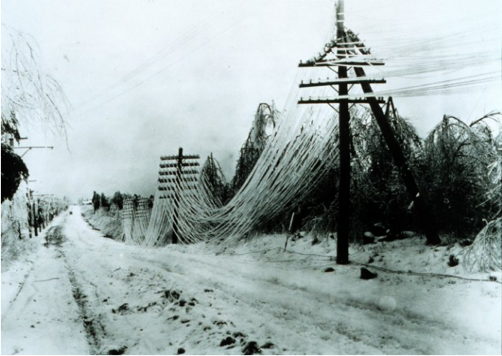I was surprised, however, that the latest provisions are not as strict as those in Albuquerque’s wireless ordinance (which, confusingly, is separate from its code for wired utilities). In Santa Fe above-ground equipment like antennas “shall be designed, installed and maintained in such a manner as to minimize the visual impact.” In Albuquerque wireless equipment must be “concealed,” and there are several paragraphs specifying exactly what that means.

Old Power Lines in an Ice Storm (stock photo)
Both cities impose additional burdens within historic districts. In Santa Fe telecom equipment must be approved by the planning department’s historic preservation staff. (In an earlier draft, a hearing by the citizens’ Historic Review Board was required, but that may be overkill.) Albuquerque mandates that wireless installations in historic neighborhoods be both concealed and “architecturally integrated.” Antennas are banned altogether from the center of Old Town (probably a violation of federal law), and any neighborhood association, historic or not, has the right to be consulted about antenna design.
As a resident of one of Santa Fe’s oldest neighborhoods, I don’t want to be shut out of the next stage of the information revolution (it takes far too long to download a high-resolution episode of Caprica), but maybe our recommended regulations for antennas need a little more tightening.
I was especially impressed by the requirements Albuquerque wrote into its agreements with Brooks Fiber and with CityLink, providers of underground optical data lines. A certain amount of unused cable or “dark fiber” (not to be confused with dark neurons) must be reserved for use, free of charge, by the citizenry — local government, the convention center, public schools, and colleges. It will be a few weeks before Santa Fe can start approving franchises under its new code. But it is important to ensure that it has the power to make similar demands.
In yesterday’s New Mexican John M. Brown, the president of CityLink, ranted about Santa Fe’s proposed $2,500 application fee and a requirement to notify neighbors living along rights-of-way. The proposed ordinance is so burdensome, he fumed, that Santa Fe customers would have to pay 2 1/2 times as much as they do in Albuquerque for the privilege of doing business with him.
CityLink CAN NOT accept this [he shouted in an email to reporter Tom Sharpe] and unless changed will NOT be servicing Santa Fe anytime soon.
Then good riddance. His competitors will be lining up at the door. Albuquerque also charges $2,500 to apply for a franchise, and for wireless providers the fee is $3,500. From what I can tell from the Albuquerque code, neighborhood notification is less stringent and is required only for wireless. So there still may be more tinkering to do before the Council’s final vote. But overall Santa Fe’s proposed regulations are far more streamlined and clear than Albuquerque’s and should help put us on the map — and in the world economy — as a great place from which to telecommute. Meanwhile I urge my readers, including those at City Hall, to nominate Santa Fe as a participant in Google’s Fiber for Communities program. The deadline is approaching fast.
George Johnson
The Santa Fe Review
